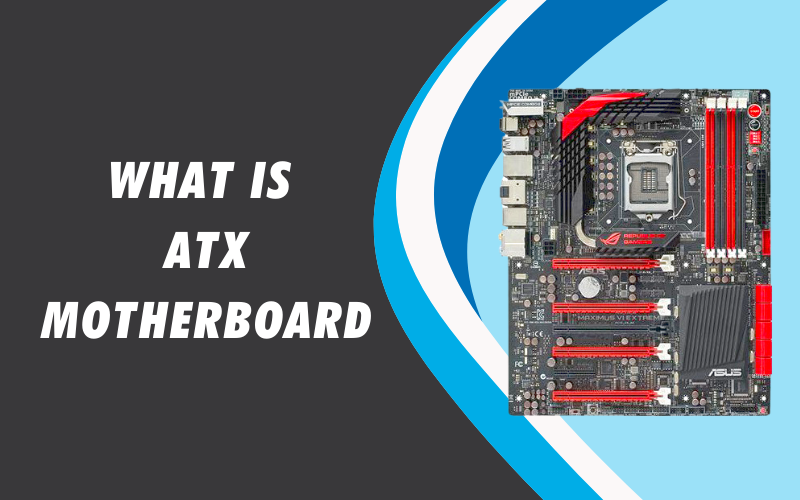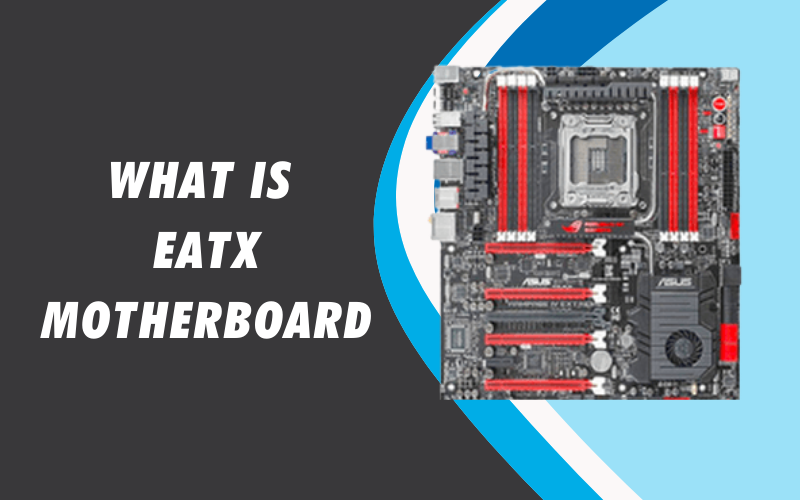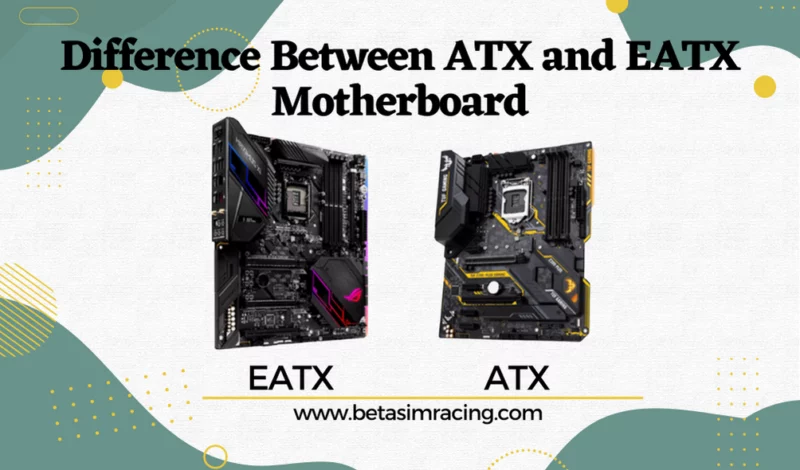Choosing the right motherboard is a foundational step in building a new PC. It dictates the size of your computer, the components you can install, and your future upgrade paths. Among the most common choices for desktop builders are the ATX and EATX form factors. While they share a common lineage, their differences in size and features are significant.
This guide provides a definitive, purely informational breakdown of ATX vs. EATX motherboards. We will explore their technical specifications, core differences, and the ideal use cases for each, empowering you to make an informed decision for your PC build.
ATX vs. EATX: Quick Comparison (2025 Specifications)
For those seeking an immediate overview, this table highlights the primary distinctions between the standard ATX and EATX form factors.
| Feature | ATX (Advanced Technology eXtended) | EATX (Extended ATX) |
| Dimensions | 12 x 9.6 inches (305 x 244 mm) | 12 x 13 inches (305 x 330 mm) |
| Typical Case Size | Mid-Tower, Full-Tower | Full-Tower, select Mid-Towers |
| Typical RAM Slots | 4 | 4 to 8 |
| Maximum RAM | Typically up to 192GB (DDR5) | Up to 256GB or more (DDR5) |
| Typical PCIe x16 Slots | 2 to 3 | 3 to 4 or more |
| Typical M.2 Slots | 2 to 4 | 4 to 6 or more |
| CPU Socket Support | Single CPU | Primarily Single CPU; Dual CPU on server/workstation boards |
| Power Delivery (VRM) | Good to Excellent | Excellent to Extreme |
| Common Use Case | Mainstream desktops, all-purpose gaming PCs | High-end gaming, content creation, workstations |
| Price Range | Moderate to High | High to Very High |
Understanding the ATX Form Factor

The Advanced Technology eXtended (ATX) motherboard has been the de facto standard for desktop PCs for over two decades. Its design, originally developed by Intel in 1995, revolutionized PC building by standardizing the layout of ports, expansion slots, and power connectors. When someone mentions a “standard” motherboard, they are almost always referring to ATX.
Its long-standing popularity means it has the widest compatibility with PC cases, power supplies, and cooling solutions. For a deeper dive into its specifications, you can explore in more detail.
Core Characteristics of an ATX Motherboard
- Standardized Size: At 12 x 9.6 inches, ATX provides a balanced layout with ample room for essential features without being excessively large.
- Sufficient Expansion: A typical modern ATX board features up to seven expansion slots, usually a mix of PCIe x16 slots for graphics cards and smaller x1 or x4 slots for other devices. It also commonly includes 2-4 M.2 slots for high-speed SSDs.
- Robust Feature Set: ATX motherboards offer a comprehensive feature set that satisfies the vast majority of users, from casual builders to serious gamers. This includes four RAM slots, plenty of SATA ports, and robust I/O panels.
Advantages and Disadvantages of ATX
Pros:
- Wide Compatibility: Works with the largest range of PC cases, from compact mid-towers to large full-towers.
- Excellent Balance: Offers a great mix of features, expansion, and size for most builds.
- Cost-Effective: Generally more affordable than their EATX counterparts with similar chipsets.
- Broad Selection: A massive variety of models are available from all major manufacturers for both Intel and AMD platforms.
Cons:
- Limited Extreme Expansion: May not offer enough PCIe or M.2 slots for users with extreme multi-GPU or storage needs.
- Tighter Building Space: While spacious enough for most, installing components can be tighter compared to the vast real estate of an EATX board.
Understanding the EATX Form Factor

The Extended ATX (EATX) form factor is, as the name implies, a larger version of the ATX standard. It maintains the same height (12 inches) but extends the width to 13 inches. This extra width is dedicated to providing more features for the most demanding users.
Key Takeaway: The primary purpose of EATX is to accommodate more components and more robust circuitry. This includes additional RAM slots, more PCIe and M.2 connectors, and more elaborate power delivery systems (VRMs) for high-end CPUs.
Core Characteristics of an EATX Motherboard
- Expanded Real Estate: The added width allows for a less crowded layout and more room for high-end components and cooling solutions.
- Maximum Expansion: EATX boards are designed for ultimate expansion. They often feature the maximum number of RAM slots (up to 8), numerous PCIe slots for multiple graphics cards or other expansion cards, and an abundance of M.2 and SATA ports.
- Enthusiast-Grade Features: These boards are typically equipped with the most powerful VRMs for extreme overclocking, advanced networking options (like dual 10GbE LAN), and premium audio solutions.
Advantages and Disadvantages of EATX
Pros:
- Unmatched Expansion: The ideal choice for multi-GPU setups, complex water-cooling loops, and extensive storage arrays.
- Superior Power Delivery: Often built with higher-quality components and more power phases to handle the most powerful processors on the market.
- Spacious Building Experience: The extra room makes assembling the PC and managing cables significantly easier.
- Aesthetic Showcase: Their size and feature density make them a centerpiece for high-end showcase builds.
Cons:
- Limited Case Compatibility: Requires a large full-tower case or a specific mid-tower designed to accommodate its extra width.
- Higher Cost: EATX motherboards command a premium price, often being the most expensive models in any chipset lineup.
- Overkill for Most Users: The majority of gamers and desktop users will not utilize the extra features, making the added cost unnecessary.
ATX vs. EATX: A Detailed Breakdown of the Differences
While the comparison table provides a quick summary, a deeper look reveals how these differences impact a PC build.

Physical Dimensions and Case Compatibility
- ATX: Measures 12 x 9.6 inches (305 x 244 mm). This size is the baseline standard supported by nearly all mid-tower and full-tower PC cases.
- EATX: Officially measures 12 x 13 inches (305 x 330 mm). Crucially, many consumer motherboards are marketed as EATX but are slightly smaller (e.g., 12 x 10.9 inches). Always check the exact dimensions of both the motherboard and the case specifications to ensure compatibility. Using proper is critical for both form factors to prevent short circuits.
Expansion Capabilities: PCIe and M.2 Slots
This is a primary differentiator. If you’re wondering , the answer will guide your choice.
- ATX: Typically provides 2-3 full-length PCIe x16 slots and 2-4 M.2 slots. This is ample for a primary graphics card, another expansion card (like a capture card), and multiple high-speed SSDs.
- EATX: Leverages its extra space to offer 3-4 full-length PCIe x16 slots and often 4-6 M.2 slots. This is designed for users running dual graphics cards for professional applications (as SLI/CrossFire is largely defunct for gaming) or those who need to populate multiple slots with high-bandwidth devices.
Memory Support: RAM Slots and Capacity
- ATX: The standard is four RAM slots. With current DDR5 technology, this allows for a maximum of 192GB of RAM (using 48GB modules).
- EATX: Consumer-focused EATX boards usually have four RAM slots as well. However, high-end desktop (HEDT) and workstation-class EATX boards can feature eight RAM slots, enabling memory capacities of 256GB or more, which is essential for heavy data processing and server-like applications.
CPU Support and Power Delivery (VRMs)
Both form factors support the same consumer CPUs from Intel and AMD. The difference lies in the power delivery system designed to support them.
- ATX: Features good to excellent Voltage Regulator Modules (VRMs) that can comfortably handle most consumer CPUs, including high-end models with moderate overclocking.
- EATX: Boards are built with overkill in mind. They feature more numerous and higher-quality power phases, larger heatsinks, and more robust power connectors. This ensures maximum stability for extreme overclocking of top-tier processors like Intel’s Core i9 or AMD’s Ryzen 9 series.
Cooling Potential and Airflow
Larger boards mean more space between components, which can aid in cooling.
- ATX: In a well-designed case, ATX boards have adequate space for effective air or liquid cooling. However, a large air cooler and a top-mounted graphics card can create a crowded area around the CPU socket.
- EATX: The increased width naturally creates more distance between the CPU socket, RAM slots, and the primary PCIe slot. This improves airflow and makes it easier to install custom water-cooling loops with large reservoirs and pumps.
Price Point and Target Audience
- ATX: Caters to the broadest market, from budget-conscious builders to high-performance gamers. Prices vary widely but are generally reasonable.
- EATX: Exclusively targets the high-end enthusiast, professional content creator, and workstation markets. These are premium products with a correspondingly high price tag.
PC Case Considerations for ATX and EATX Builds
The motherboard form factor you choose directly impacts your choice of PC case. Here are five examples of PC cases from the market that illustrate compatibility with these motherboard sizes.
High-Airflow Mid-Tower: Cooler Master MasterBox TD500 Mesh V2
A prime example of a modern ATX case, the TD500 Mesh V2 is designed for maximum cooling performance. Its mesh front panel allows for massive air intake. While it is built primarily for ATX, its spacious interior and standard layout make it a versatile choice for the majority of gaming builds. It does not officially support the full EATX width.
Dual-System Super Tower: Corsair Obsidian 1000D
This is the definition of a super-tower, built to house the most extreme systems. It can famously accommodate a full EATX primary system and a secondary Mini-ITX system simultaneously, making it ideal for users who want to game and stream from a single chassis. Its immense size provides unparalleled support for custom liquid cooling.
Popular EATX-Compatible Mid-Tower: Lian Li O11 Dynamic EVO
The O11 series is exceptionally popular for its dual-chamber design and aesthetic appeal. The EVO model is notable for its versatility, offering official support for EATX motherboards (up to 280mm wide) in a mid-tower footprint. This makes it a popular choice for builders who want EATX features without committing to a massive super-tower.
Open-Frame Micro-ATX Case: Thermaltake AH T200
It is critical to note that the Thermaltake AH T200 is a Micro-ATX case, not an ATX or EATX case. Its inclusion here is to highlight the importance of matching form factors. Its unique, helicopter-inspired open-frame design is visually striking but is physically designed for the smaller Micro-ATX and Mini-ITX motherboards. An ATX or EATX board will not fit in this chassis. This illustrates why understanding the is so important.
Advanced EATX Mid-Tower: Cougar MX660-G RGB
This case represents a more traditional mid-tower design that has been expanded to support EATX motherboards. It combines a striking front panel with strong airflow potential and the internal volume needed for larger components. It demonstrates that builders can find EATX support in cases that still fit a standard mid-tower profile.
Which Form Factor Is Right for Your Build?
Ultimately, the decision comes down to your specific needs, budget, and future aspirations. Debating often comes down to these form factor limitations.
Scenarios for Choosing an ATX Motherboard
- You are a gamer or general user: For nearly all gaming and desktop tasks, ATX provides all the features and expansion you will ever need. You can build a top-tier gaming PC around an ATX board without issue.
- Your budget is a key consideration: ATX offers the best performance-per-dollar, as you aren’t paying for extreme features you won’t use.
- You prefer a mid-tower case: If you want a PC that doesn’t dominate your desk space, the wider selection of mid-tower cases available for ATX is a significant advantage.
Scenarios for Choosing an EATX Motherboard
- You are a professional content creator: Video editors, 3D artists, and other professionals who rely on multiple GPUs or other specialized PCIe cards will benefit from the extra slots.
- You are an extreme overclocking enthusiast: The superior power delivery and more spacious layout of EATX boards are purpose-built for pushing high-end CPUs to their absolute limits.
- You are building a custom water-cooled masterpiece: The additional real estate makes it significantly easier to plan and install complex tubing runs, reservoirs, and pumps.
- Budget is not a primary concern: If you simply want the most feature-rich and powerful platform available, EATX is the top choice.
Frequently Asked Questions (FAQ)
Will an ATX motherboard fit in an EATX case?
Yes, absolutely. EATX cases are larger and use the same core mounting points as ATX boards. Any case that supports EATX will also support ATX, Micro-ATX, and Mini-ITX.
Can an EATX motherboard fit in an ATX case?
Rarely. A standard ATX mid-tower case will not accommodate the extra width of an EATX motherboard. The board would overhang the standoff holes and likely interfere with drive bays or cable routing channels. You must use a case that explicitly lists EATX support in its specifications.
What are the exact dimensions for ATX vs. EATX?
Standard ATX measures 12 x 9.6 inches (305 x 244 mm). Full-spec EATX measures 12 x 13 inches (305 x 330 mm), though many consumer versions are slightly less wide.
Do EATX motherboards provide better performance?
Not inherently. An EATX and an ATX motherboard using the same CPU, RAM, and GPU will perform identically in stock configurations. The performance advantage of EATX comes from its potential for more extreme overclocking, support for more expansion cards, and capacity for more RAM, which are only beneficial in specific, high-demand workloads. For gaming, the motherboard form factor itself has a negligible impact on framerates. The question of is more about chipset features and VRM quality than size alone.
Are Micro-ATX and Mini-ITX related to ATX?
Yes, they are smaller variations of the ATX standard. Micro-ATX (9.6 x 9.6 inches) is shorter, resulting in fewer PCIe slots. Mini-ITX (6.7 x 6.7 inches) is the smallest common form factor, with only one PCIe slot and two RAM slots, designed for compact builds.
Is EATX necessary for high-end gaming?
No, it is not. A high-quality ATX motherboard is more than sufficient for even the most powerful single-GPU gaming builds. EATX is a luxury for gamers, offering more room to build and an enthusiast aesthetic, rather than a necessary component for performance.

Holding a Ph.D. in Computer Science, Dr. Alistair Finch is our chief PC Component Benchmark Analyst. He provides meticulous, data-driven analysis of CPUs and GPUs, moving beyond marketing claims to reveal their true performance. His guides help readers understand the intricate relationship between hardware architecture and real-world gaming frame rates.
